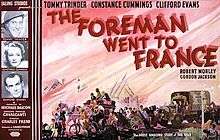The Foreman Went to France
| The Foreman Went to France | |
|---|---|
 Original UK quad format poster | |
| Directed by | Charles Frend |
| Produced by | Michael Balcon |
| Screenplay by |
Leslie Arliss John Dighton Angus MacPhail |
| Story by | J. B. Priestley |
| Starring |
Clifford Evans Tommy Trinder Constance Cummings Gordon Jackson |
| Music by | William Walton |
| Cinematography | Wilkie Cooper |
| Edited by | Robert Hamer |
Production company | |
| Distributed by | United Artists Ltd (UK)[1] |
Release dates |
|
Running time | 87 minutes [1] |
| Country | United Kingdom |
| Language | English |
The Foreman Went to France (released in the USA as Somewhere in France [2]) is a 1942 British Second World War war film starring Clifford Evans, Tommy Trinder, Constance Cummings and Gordon Jackson. It was based on the real-life wartime exploits of Welsh munitions worker Melbourne Johns, who rescued machinery used to make guns for Spitfires and Hurricanes.[3] It was an Ealing film made in 1941 with the support of the War Office and the Free French Forces. The script was by J.B.Priestley and reflects both optimism about an eventual victory and the sense that the post war world would have to be different from that of the 1930s. All of the 'heroes' are portrayed as ordinary people caught up in the war.[4] The score was written by William Walton.
Plot
Welsh factory foreman Fred Carrick (Clifford Evans) goes to France on his own initiative to retrieve several pieces of valuable machinery ahead of the German invasion. Along the way, he is helped by two soldiers (Tommy Trinder, Gordon Jackson) and an American woman (Constance Cummings). To get to France, Fred has to get round the opposition of his firm's bosses and British civil servants. While in France, he has to learn about the role of the fifth column. His gradual realisation of how authority can trick him has been argued to be an allegory to Britain learning not to be to be too trusting but also through the role of an Anne Stafford, an American woman, an anticipation of an eventual alliance with the United States.[5] During the race to the coast with the machines, the film evokes the huge scale of the flood of refugees that fled the advancing Nazis in France in 1940.
Cast
- Clifford Evans as Fred Carrick, the foreman
- Tommy Trinder as Tommy Hoskins
- Constance Cummings as Anne Stafford
- Robert Morley as Mayor Coutare of Bivary
- Gordon Jackson as Alastair 'Jock' MacFarlan.
- Ernest Milton as the stationmaster in La Tour
- Charles Victor as the aircraft spotter on the Works roof
- John Williams as the 'English' army captain
- Paul Bonifas as the Prefect of Rouville
- Anita Palacine as a La Tour barmaid
- Francis L. Sullivan as a French skipper
- Mervyn Johns as Official, Passport Office
- Sidney Adams as Driver
- Owen Reynolds as Collins, Burns & Fawcett Works Manager
- Ronald Adam as Sir Charles Fawcett, Managing Director
- Eric Maturin as Older Man (uncredited)
References
- 1 2 BBFC: The Foreman Went to France - Distributor(s) United Artists Corp. Ltd Linked 2015-12-06
- ↑ Slide, Anthony: Some Joe You Don't Know: An American Biographical Guide to 100 British Television Personalities, page 124, Greenwood Publishing Group, 1996 Linked 2015-12-06
- ↑ Duncan Higgitt. "War hero out of oblivion". WalesOnline.co.uk. Retrieved 2008-08-01.
- ↑ Judith Cook, Priestley, London: Bloomsbury, 1997, p. 179
- ↑ K.M.Johnson, The Great Ealing Film Challenge 50: The Foreman Went to France (1942)
External links
- The Foreman Went to France at the British Film Institute's Screenonline
- The Foreman Went to France in the British Film Institute's "Explore film..." database
- The Foreman Went to France at the British Board of Film Classification
- The Foreman Went to France at the Internet Movie Database
- The Foreman Went to France at AllMovie
| ||||||